If you have looked at our video, you will see 3 games played outdoors, followed by another drag-and-drop puzzle indoors. The new version now has 5 games to be played outdoors. The game has a general narrative where various archaeological clues lead to the discovery of a building, it’s mapping out, digging up, and finally exhibiting in a museum. Whilst the overall aim is to have fun, the simulation draws upon techniques used on real archaeology digs. You can see some of these techniques for real if you go on a dig, or from the comfort of your armchair particularly on programmes like Time Team. When you press Play, or when the game changes between players, a short version of the instructions appear. This is just to remind you what to do. It helps to have a good overall idea of what you are doing in advance. The texts for the 5 games are shown below too, but here is how it looks on the tablet. 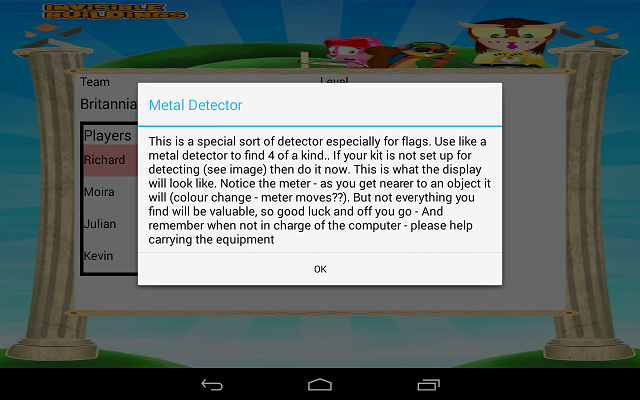 Once you press ok, you will have started the game, and the timer is ticking so be ready to get going. There are a few things that are common to all games, in particular, the area to the right of the screen. Here we have:
Once you press ok, you will have started the game, and the timer is ticking so be ready to get going. There are a few things that are common to all games, in particular, the area to the right of the screen. Here we have:
- The current player who is in charge of the tablet, the score (oh dear, Richard, you have null points).
- The time left in this part of the game for you as a player
- A list of all the people in the team (in order of play) and their total points to date
- The progress bar which gives an indication of how far through the game you have got (based on how long you set the game time to – i.e. if it is one hour, after 30 minutes the progress bar will be half red and half green)
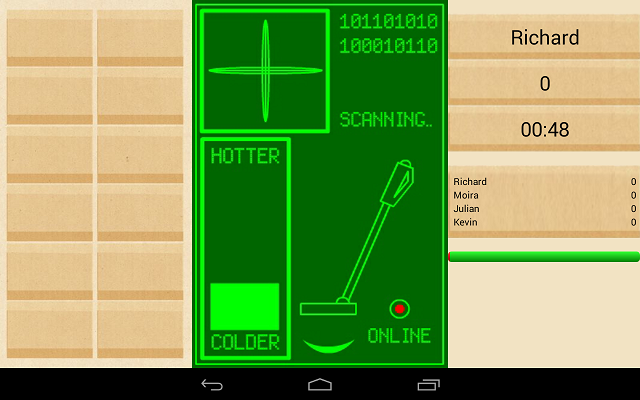 Looking now at this screen as the Metal Detector, you can see a set of boxes to the left where our “found” objects will be displayed when detected, and the central green area which is the control centre for the metal detector. Most of this area whirls and dings when in exploring. The key area to watch is the “hotter-colder” meter. Currently this has 3 boxes, green when in range, yellow when close, and red when very close – soon we will upgrade this to a multi bar graph display. According to the difficulty level, we will also display your distance from the object. This is the help text for the metal detector: Who’s used a metal detector before? Guess what it’s for. If your kit is not set up for detecting (see image) then do it now. This is what the display will look like. Notice the meter – as you get nearer to an object it will (colour change – meter moves??). But not everything you find will be valuable, so good luck and off you go. And remember when not in charge of the computer – please help carrying the equipment. Now let’s move on to the next game – the Squirrel Sorter.
Looking now at this screen as the Metal Detector, you can see a set of boxes to the left where our “found” objects will be displayed when detected, and the central green area which is the control centre for the metal detector. Most of this area whirls and dings when in exploring. The key area to watch is the “hotter-colder” meter. Currently this has 3 boxes, green when in range, yellow when close, and red when very close – soon we will upgrade this to a multi bar graph display. According to the difficulty level, we will also display your distance from the object. This is the help text for the metal detector: Who’s used a metal detector before? Guess what it’s for. If your kit is not set up for detecting (see image) then do it now. This is what the display will look like. Notice the meter – as you get nearer to an object it will (colour change – meter moves??). But not everything you find will be valuable, so good luck and off you go. And remember when not in charge of the computer – please help carrying the equipment. Now let’s move on to the next game – the Squirrel Sorter.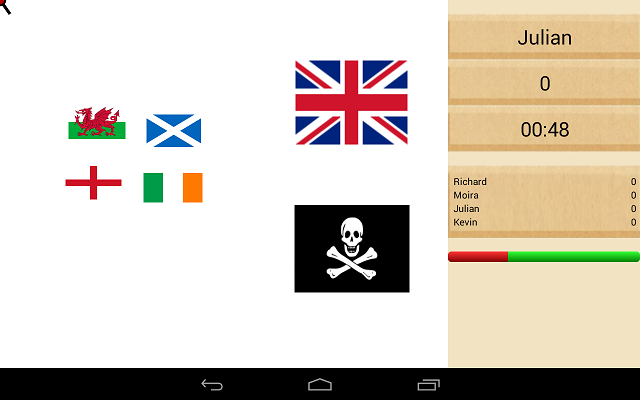 In this game we see the objects that we found with the metal detector and have to move them either to the good area or the bad one (or bin). Note that you can see where we are at the top right hand side of the screen – looking like a little tadpole. The round bit indicates our position and the line, our direction of travel. Move to an object, click on it, and it will move with you. Depending on your judgement, move to the museum or the bin. Click when you are directly over it to score your points.
In this game we see the objects that we found with the metal detector and have to move them either to the good area or the bad one (or bin). Note that you can see where we are at the top right hand side of the screen – looking like a little tadpole. The round bit indicates our position and the line, our direction of travel. Move to an object, click on it, and it will move with you. Depending on your judgement, move to the museum or the bin. Click when you are directly over it to score your points.
The help text on the screen is as follows: Decide if the artifacts are Roman which should be sent to the museum or junk which should be thrown away. 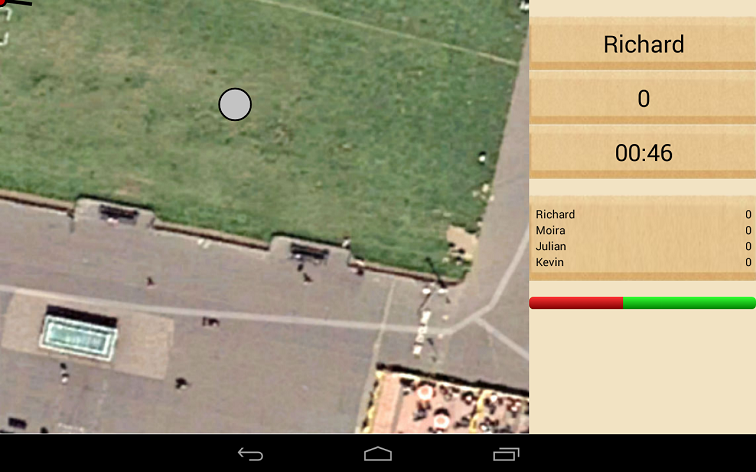 We now come to the GeoPhys part of the game. Here is where we find evidence of a building “hiding” underground. When geophys (or geo-physics) is carried out on a real dig, the electrical state of the ground is measured with sensitive equipment – really consider it like underground radar.
We now come to the GeoPhys part of the game. Here is where we find evidence of a building “hiding” underground. When geophys (or geo-physics) is carried out on a real dig, the electrical state of the ground is measured with sensitive equipment – really consider it like underground radar.
Normally, the geophys survey is carried out by marching up and down the field rather like one would cut the grass, but our machine is more sophisticated and gives you points to aim towards (see the grey circle in the picture above). Once you reach this point, you will be directed to the next point and so on. As you move, so a layer beneath the surface is exposed, and this continues until the whole picture is revealed.
Note that this and the following games all use the image that you have uploaded to the tablet. You can put anything here, but obviously something helpful is prefered.
Our guidance text says: Introduction to show that things underground can be “seen” First way is will aerial photos and then showing that the ground can be investigated like x-rays with the equipment they are about to use. Instructions for putting together the equipment. Plan for how do walk – will vary according to difficulty (width of “reveal” to vary – and to make more fun will be given target points to go to 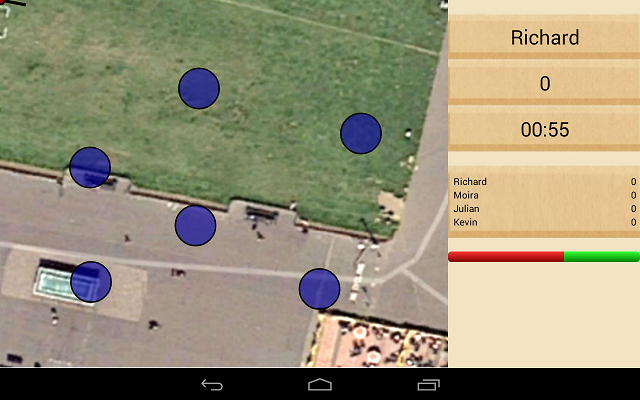
Now we know where the building lies underground, it’s time to start digging. A number of points have been selected where we think it will be good to dig. You need to move to these in turn and dig. We assemble the digging machine and with the help of the team, we run round in circles. (What is actually happening here is that we are watching the compass go round – so as long as the tablet is going in circles we are digging). You can see the mole going round to indicate how fast we are digging, and you can see the progress we are making by the progress of the cannister as it goes into the ground.
Once you have got down far enough, the building piece is lifted up and we can see it. In the next game we will make a model of this and take it to the museum.
Here are our on-screen instructions: We now want you to dig up the building that is underground. Of course you can do this really, but we have created what we call the “Mole Digger” By running around at certain points the mole will go into the ground and look around and create an image of what is there. Do this in 12 points and you should have the whole building We will put the geophys diagram on the screen to help you select the best points to dig. If the mole thinks the place selected is not good he will tell you 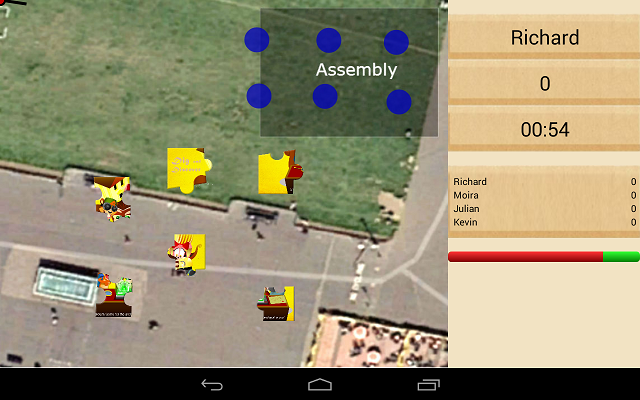 We have arrived at the last game: Diggory Drop. Now you should be able to see all the bits that have been dug up. Your final task is to move them to the assembly area in the museum. You do this as per the Squirrel Sort by going to a bit and selecting it, and then moving with it to the correct place in the museum. Once it is there, go and get the next bit, until at the very end, they are all in position. Once it is all done, you will be able to see what the building looked like, back when it was new.
We have arrived at the last game: Diggory Drop. Now you should be able to see all the bits that have been dug up. Your final task is to move them to the assembly area in the museum. You do this as per the Squirrel Sort by going to a bit and selecting it, and then moving with it to the correct place in the museum. Once it is there, go and get the next bit, until at the very end, they are all in position. Once it is all done, you will be able to see what the building looked like, back when it was new.
The text on screen goes like this: I am just collecting the pieces you found. If you drag them onto the stage, you will see what the complete building looks like.